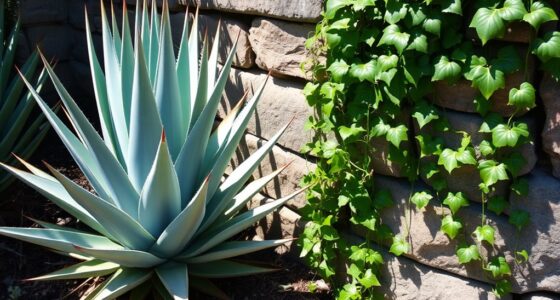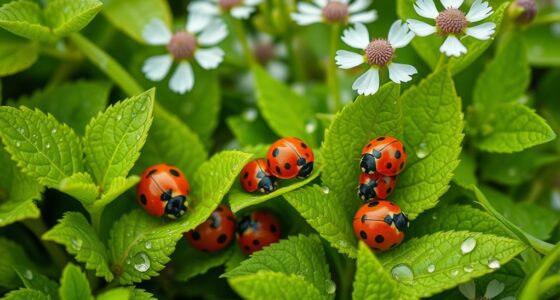To improve your grapevines, plant companions like marigolds, nasturtiums, and herbs such as lavender, basil, and oregano. These flowers repel pests and attract beneficial insects that control pests naturally. Include legumes, clover, and comfrey to enrich your soil, while cover crops help prevent erosion. Adding ornamental plants like foxglove enhances biodiversity and attracts pollinators. Continue exploring to discover how these plants work together to create a resilient vineyard ecosystem.
Key Takeaways
- Incorporate pest-repelling flowers like marigolds and nasturtiums to naturally control vineyard pests.
- Use beneficial plants such as lavender, yarrow, and coneflowers to attract pollinators and beneficial insects.
- Plant legumes and comfrey to enrich soil nutrients and improve soil health sustainably.
- Establish cover crops like rye, oats, and clover to prevent soil erosion and enhance soil fertility.
- Add vibrant, low-growing flowers to improve vineyard aesthetics and promote biodiversity.
Marigolds and Other Pest-Repelling Flowers
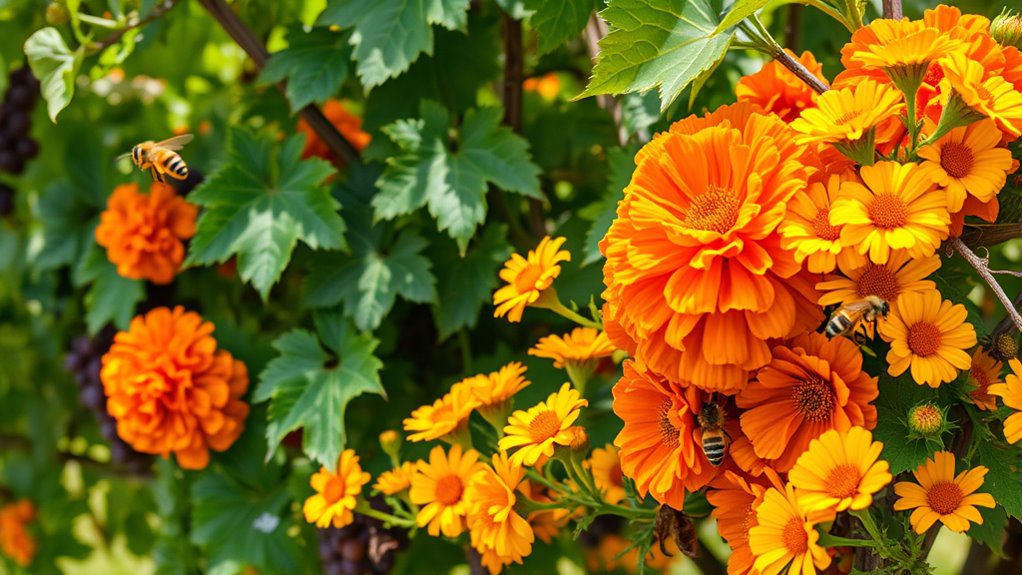
Marigolds and other pest-repelling flowers are valuable companions for grapevines because they naturally deter harmful insects. Planting these flowers along your vineyard’s edges or interspersed among the vines creates a natural barrier against pests like aphids, beetles, and nematodes. Marigolds release compounds that repel many common vineyard pests, reducing the need for chemical treatments. Their bright colors attract beneficial insects such as pollinators and predatory bugs that help keep pest populations in check. Additionally, pest-repelling flowers improve soil health by attracting beneficial organisms that break down organic matter. Incorporating integrated pest management strategies with insect-repelling plants can enhance your pest management strategies and foster a balanced vineyard ecosystem. By incorporating marigolds and similar flowers into your grape-growing area, you enhance pest management naturally, promoting healthier vines and potentially increasing your harvest quality without relying heavily on pesticides. Furthermore, planting these beneficial insects can lead to a more sustainable approach to vineyard care over time. Including natural pest control options like these reduces dependency on chemical pesticides, which benefits both the environment and crop safety. Additionally, selecting pest-repelling flowers that attract beneficial pollinators can further support the vitality and productivity of your grapevines.
Nasturtiums for Natural Pest Control
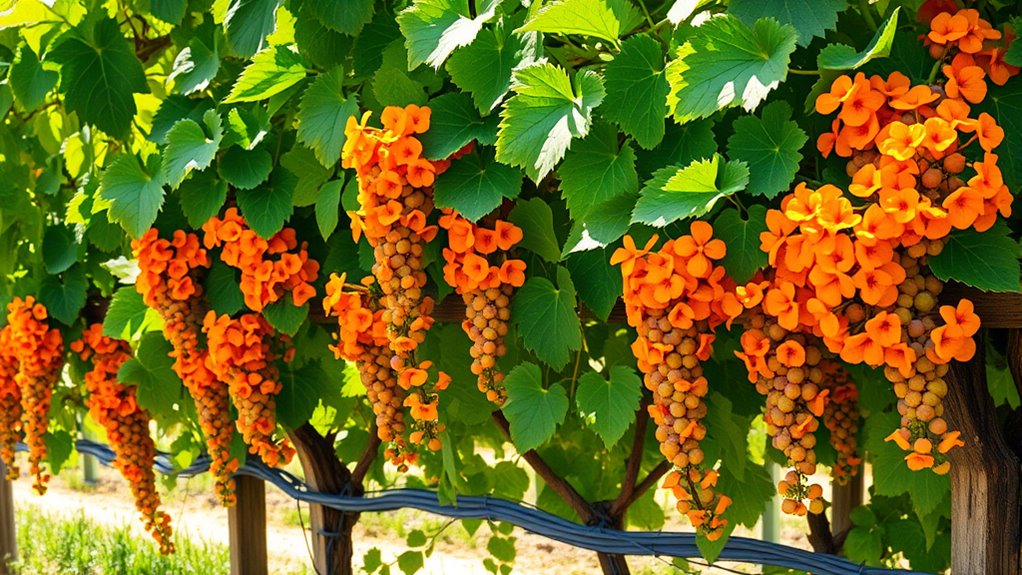
Nasturtiums act as natural pest deterrents, keeping unwanted insects away from your grapevines. They attract beneficial insects that help control pests, boosting your garden’s health. Plus, their bright blooms add a lively, attractive touch to your vineyard landscape. Incorporating companion planting techniques can further enhance pest control and plant health. Additionally, selecting plants that promote plant health can support the overall resilience of your vineyard. Using best gardening practices ensures your grapevines and companion plants thrive together. Incorporating seed-based plants can also contribute to a balanced ecosystem by attracting helpful insects and providing ground cover. Incorporating a variety of edible plants, like herbs and vegetables, can also create a diverse ecosystem that supports beneficial insects and improves overall vineyard sustainability.
Pest Deterrent Properties
While nasturtiums are often admired for their vibrant appearance, they also serve as effective natural pest deterrents when planted near grapevines. Their strong scent masks the aroma of grapes, confusing pests like aphids and whiteflies, which find it harder to locate their target. Nasturtiums also attract beneficial insects that prey on common grape pests, helping keep infestations under control. Additionally, they repel beetles and squash bugs, which can damage grapevine roots and leaves. By planting nasturtiums, you create a barrier that discourages pests from settling near your grapes, reducing the need for chemical interventions. Proper filtration of water and sprays enhances the effectiveness of pest control measures, ensuring that beneficial insects are not harmed and that treatments reach their target. Incorporating companion planting strategies like this promotes a balanced and sustainable vineyard environment. Their presence not only enhances your vineyard’s aesthetic but also promotes a healthier, pest-resistant environment for your grapevines. Furthermore, understanding the importance of road signs can help in maintaining safety during vineyard visits and inspections.
Attractive to Beneficials
Because they emit a strong scent, nasturtiums attract beneficial insects that help control grapevine pests. These insects include ladybugs, hoverflies, and parasitic wasps, which prey on aphids, whiteflies, and other pests that threaten your grapes. By planting nasturtiums near your vines, you create a natural trap that lures these helpful bugs into your garden. They patrol the area, reducing pest populations without the need for chemical interventions. Nasturtiums also serve as a habitat for pollinators, supporting overall plant health. Their bright, colorful blooms draw beneficial insects in, making them a simple yet effective addition to your grapevine companion planting strategy. This natural pest control method encourages a balanced ecosystem, promoting healthier grape growth. Regular health checks of your plants can help detect pest issues early and maintain a healthy vineyard environment. Additionally, understanding projector contrast ratios can help you optimize your gardening space’s lighting conditions for better plant growth. Incorporating integrated pest management practices can further enhance your vineyard’s resilience against pests and diseases. Proper soil health management can also improve plant vigor and resistance to pests.
Enhances Garden Aesthetics
Adding nasturtiums to your grapevine garden not only helps control pests but also boosts its visual appeal. Their vibrant, colorful blooms create a striking contrast against the green foliage of your grapes, adding a lively splash of color. Nasturtiums trail beautifully along the ground or climb nearby trellises, softening the garden’s overall look. Their cheerful flowers and lush leaves introduce a sense of charm and warmth, making your garden more inviting. Plus, their low-growing habit doesn’t overshadow your grapevines, allowing both to flourish visually. With their bright, eye-catching appearance, nasturtiums elevate the garden’s aesthetic while serving a practical purpose. This combination of beauty and function turns your grapevine space into an attractive, lively oasis. Additionally, incorporating companion planting strategies like this can promote healthier grapevines and reduce the need for chemical interventions. Understanding return policies at local garden centers can also ensure smooth exchanges if you need to replace plants or supplies. Moreover, selecting plants with beneficial properties can further enhance your garden’s health and productivity. Incorporating plant diversity can also support beneficial insects and improve overall garden resilience. Engaging in self-assessment can help you identify which companion plants work best for your specific garden conditions.
Borage to Boost Vine Health and Productivity

Plant borage near your grapevines to improve soil nutrition and naturally repel pests. It also attracts beneficial insects that help keep your vineyard balanced. Incorporating borage can boost your vines’ health and overall productivity effortlessly. Leveraging AI in Business insights can further optimize vineyard management practices. Additionally, understanding noise levels of modern heat pumps can aid in selecting quieter equipment for vineyard site comfort. Proper Gold IRA Rollovers knowledge can also inform investment strategies that secure your vineyard’s financial future.
Enhances Soil Nutrition
Borage is a powerful companion plant that can substantially enhance soil nutrition for grapevines. Its deep roots draw up minerals from lower soil layers, making nutrients more available to your vines. When you plant borage nearby, it gradually releases these minerals into the soil as it decomposes, enriching the nutrient profile. Borage also attracts beneficial insects and pollinators, which support overall plant health and fruit development. Additionally, its taproots help break up compacted soil, improving aeration and water absorption. By incorporating borage into your vineyard, you create a more fertile environment that promotes vigorous vine growth and higher yields. Its ability to boost soil nutrients makes it a valuable addition for maintaining healthy, productive grapevines over time.
Repels Pests Naturally
Because of its natural pest-repelling properties, borage is an excellent companion for protecting grapevines from common pests. Borage releases compounds that deter aphids, beetles, and other insects that can damage your grapes. When planted nearby, it creates a barrier that confuses pests and reduces their attraction to your vines. Additionally, borage’s strong scent masks the signals pests rely on to locate grape leaves, decreasing infestations. Its presence also helps disrupt pest life cycles, making it harder for outbreaks to establish. By planting borage, you actively reduce the need for chemical pesticides, promoting a healthier vineyard environment. Not only does it ward off pests, but it also adds a vibrant touch to your garden, supporting overall vine health and productivity.
Attracts Beneficial Insects
By attracting beneficial insects, borage plays a vital role in maintaining a healthy vineyard ecosystem. It draws in pollinators like bees, which enhance grape pollination and fruit set. Additionally, borage attracts predatory insects such as ladybugs and hoverflies that target common grape pests like aphids and mites. This natural pest control reduces the need for chemical interventions, promoting sustainable cultivation. You’ll notice more robust vines and better yields when you include borage in your vineyard. To maximize benefits, plant borage near grapevines to encourage these helpful insects to stay and protect your crop.
- Attracts pollinators for improved fruit set
- Draws in predatory insects for pest control
- Enhances overall vineyard health and productivity
Clovers and Legumes for Soil Enrichment

Clovers and other legumes are excellent companions for grapevines because they naturally fix nitrogen in the soil, enriching it for healthier vine growth. When you plant these legumes, they form a symbiotic relationship with bacteria in their roots, converting atmospheric nitrogen into a form plants can absorb. This process reduces the need for synthetic fertilizers, promoting sustainable gardening. Legumes like clover also help improve soil structure by adding organic matter as they decompose. Their roots prevent erosion and enhance water retention, creating a more stable environment for your grapevines. By incorporating clovers and legumes into your vineyard, you boost soil fertility naturally, support strong vine development, and create a healthier ecosystem overall. This simple addition can markedly enhance your grape-growing success.
Lavender to Deter Pests and Attract Beneficial Insects
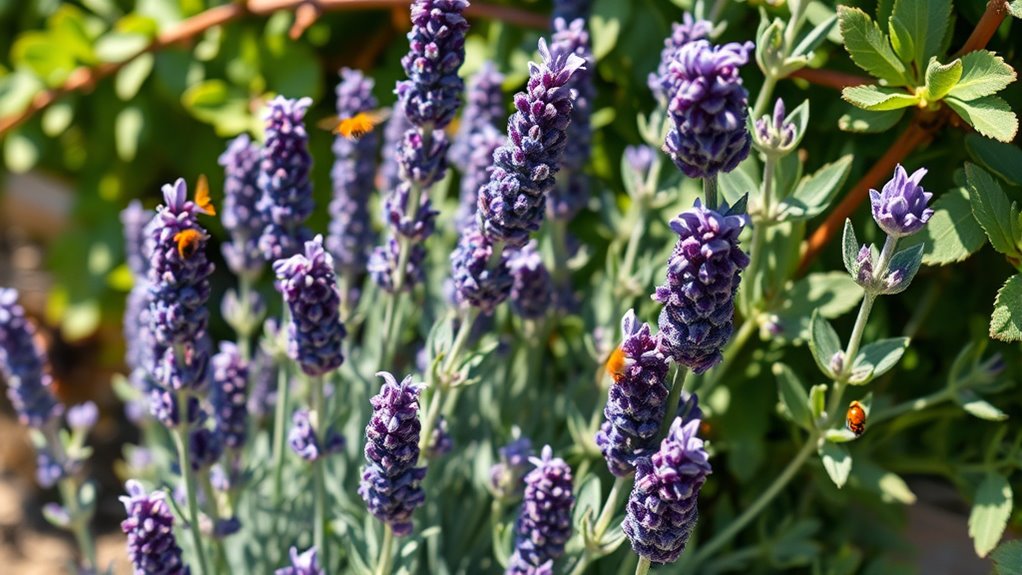
Lavender is an excellent companion plant for grapevines because it naturally deters many common pests while attracting beneficial insects. Its strong scent confuses pests like moths, beetles, and aphids, reducing the likelihood of infestations. Additionally, lavender draws in pollinators and predatory insects that help keep pest populations in check. By planting lavender near your grapes, you create a protective barrier that minimizes chemical interventions.
Consider these benefits:
- Repels harmful insects naturally
- Attracts pollinators like bees
- Draws in beneficial predators such as ladybugs and lacewings
Planting lavender strategically can boost your vineyard’s health and yield. Its aromatic flowers add beauty and fragrance to your garden while supporting a balanced ecosystem.
Comfrey as a Dynamic Accumulator
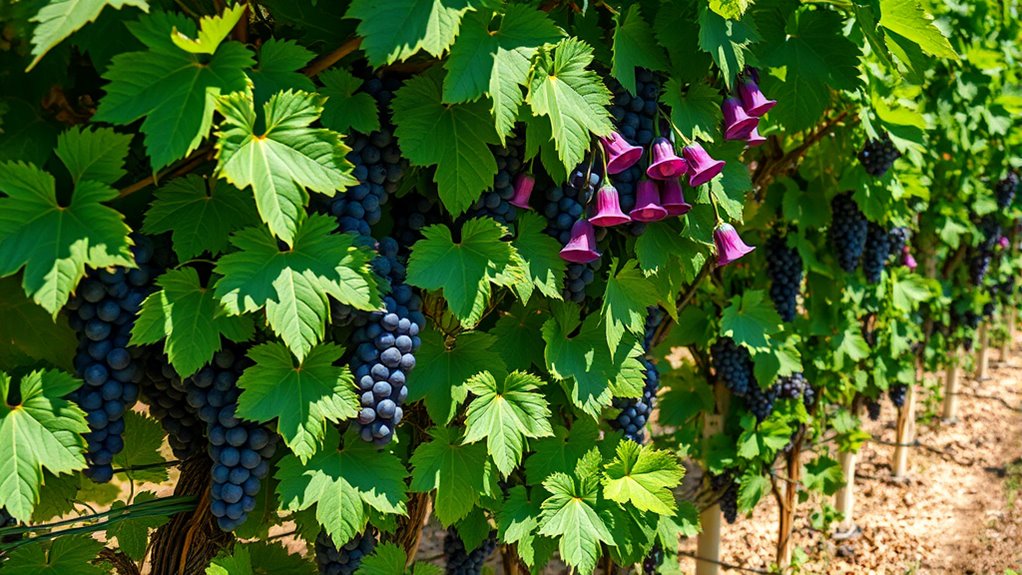
Comfrey is a powerful companion plant for grapevines because it acts as a dynamic accumulator, drawing up nutrients from deep within the soil. Its deep roots access minerals and trace elements unavailable to surface-rooted plants, enriching the surrounding soil with these nutrients when you mow or chop it back. This process naturally fertilizes your grapevines, reducing the need for chemical inputs. Comfrey’s leaves are rich in potassium, calcium, and nitrogen, essential for healthy grape growth and fruit production. By planting comfrey nearby, you support soil health and improve nutrient availability. Plus, its lush foliage provides organic matter that decomposes quickly, further boosting soil fertility. Incorporating comfrey into your vineyard creates a sustainable, nutrient-rich environment for your grapes to thrive.
Herbs Like Basil and Oregano for Pest Deterrence

Planting herbs like basil and oregano near your grapevines can effectively deter pests and reduce the need for chemical controls. These herbs emit strong scents that repel common grape pests such as aphids, beetles, and spider mites. Their aromatic oils confuse pests and make your vines less attractive for feeding or laying eggs. Additionally, basil and oregano are easy to grow and maintain, making them practical choices for your vineyard.
- Repel harmful insects naturally
- Enhance air circulation around vines
- Add flavor and variety to your garden
Sweet Alyssum for Attracting Beneficial Insects

Sweet alyssum is an excellent companion plant for grapes because it attracts beneficial insects that naturally control pests. When you plant sweet alyssum near your grapevines, it draws in pollinators like bees and predatory insects such as ladybugs and hoverflies. These insects hunt down common grape pests like aphids, mites, and whiteflies, reducing the need for chemical interventions. The small, fragrant flowers of alyssum bloom continuously, providing a steady food source for beneficial insects throughout the growing season. By incorporating sweet alyssum into your vineyard, you encourage a balanced ecosystem that supports healthy grape production. Plus, its low-maintenance nature makes it easy to integrate into your existing planting layout, creating a natural pest management system that benefits your grapes.
Foxglove and Ornamental Plants for Biodiversity

Incorporating foxglove and other ornamental plants into your vineyard can markedly enhance biodiversity by attracting a variety of beneficial insects and pollinators. Foxglove’s tall, tubular flowers draw hummingbirds, bees, and butterflies, boosting pollination rates. Its vibrant blooms add visual appeal while supporting ecosystem health. Other ornamental plants like lavender, coneflowers, and yarrow can further diversify your landscape. These plants provide nectar and habitat for pollinators, reducing pest populations naturally. Plus, they encourage a balanced environment that promotes healthy vine growth. By integrating these plants, you create a resilient vineyard ecosystem. Remember, selecting native or well-adapted ornamental species ensures they thrive and support your vineyard’s biodiversity effectively.
- Attracts pollinators like bees and butterflies
- Provides habitat for beneficial insects
- Enhances visual appeal and ecosystem health
Cover Crops for Erosion Control and Soil Quality
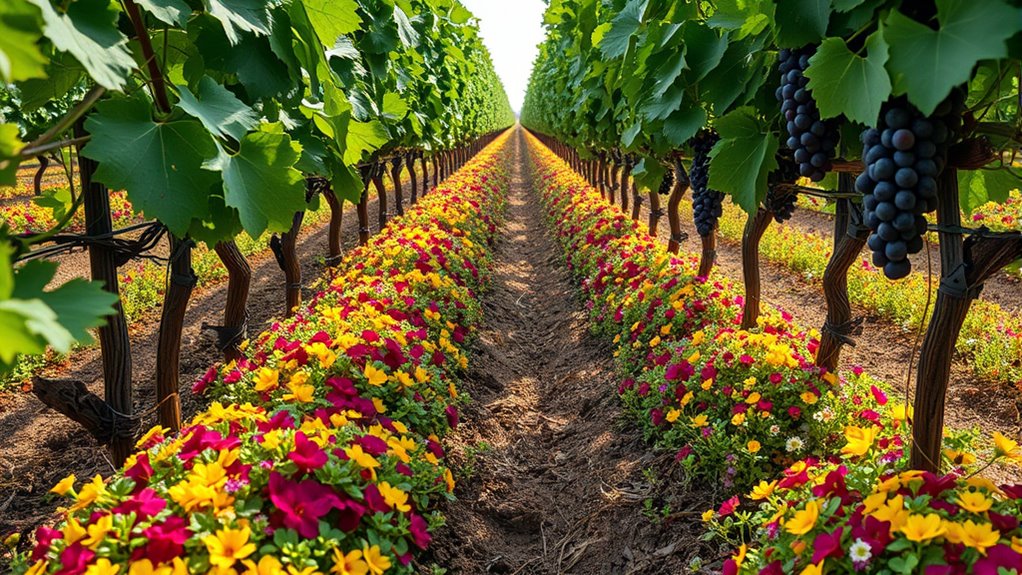
Using cover crops helps prevent soil erosion and keeps your vineyard’s soil healthy. They anchor the soil, reducing runoff during heavy rains, and improve nutrient levels naturally. Choosing the right cover crops can make a significant difference in maintaining long-term soil quality and stability.
Erosion Prevention Strategies
Erosion can quickly undermine grapevines’ root systems and degrade soil quality, but planting cover crops offers an effective solution. By establishing grasses or legumes between your vines, you create a natural barrier that stabilizes the soil and minimizes runoff. These cover crops help absorb water, reducing the force of rain impacting the soil surface. They also improve soil structure, making it more resistant to erosion over time. To maximize these benefits, consider planting:
- Fast-growing grasses like rye or oats
- Legumes such as clover or vetch
- Deep-rooted plants like sweet clover
These options not only protect your soil but also promote long-term vineyard health. Proper cover crop management guarantees erosion stays in check and your soil remains fertile.
Soil Nutrient Enhancement
Cover crops not only prevent soil erosion but also enhance soil fertility by adding essential nutrients. When you plant legumes like clover or vetch between your grape vines, they fix nitrogen from the air, enriching the soil naturally. These crops also improve soil structure by increasing organic matter, which boosts water retention and aeration. As cover crops grow, they suppress weeds, reducing competition for nutrients. After you mow or till them under, their decomposing roots release crucial minerals, providing a steady nutrient supply for your grapes. Incorporating cover crops into your vineyard supports long-term soil health, helping your vines thrive. Plus, healthy soil reduces the need for chemical fertilizers, making your vineyard more sustainable and productive.
Frequently Asked Questions
Can Companion Plants Improve Grape Flavor and Fruit Quality?
Companion plants can definitely enhance grape flavor and fruit quality. By planting herbs like basil or mint nearby, you can improve pest control and attract beneficial insects, reducing disease and stress on your vines. These plants also help improve soil health and provide shade, which can lead to better fruit development. Overall, choosing the right companions supports healthier vines, resulting in tastier grapes with higher quality.
Are There Specific Plants That Help Grapevines Resist Diseases?
Think of your grapevines as a fortress; planting certain allies can strengthen their defenses. Herbs like garlic and chives, along with marigolds, release natural compounds that fight diseases like powdery mildew and gray mold. You might recall a vineyard where adding these plants reduced disease incidence by 30%. By choosing these companion plants, you actively bolster your grapevines’ resilience, helping them stay healthy and productive.
How Do Companion Plants Affect Grapevine Watering and Nutrient Needs?
Companion plants influence your grapevine’s watering and nutrient needs by improving soil health and reducing competition. They can help retain moisture, which means you might need less frequent watering, and fix nutrients like nitrogen, benefiting your grapevines’ growth. By selecting the right companions, you create a balanced environment that supports healthy roots and reduces stress, ultimately leading to better grape production.
Which Plants Are Best for Attracting Pollinators to Grapevines?
To attract pollinators to your grapevines, you should plant flowers that draw bees, butterflies, and other beneficial insects. Consider planting lavender, sunflowers, daisies, and bee balm near your vines. These flowers provide nectar and pollen, encouraging pollinator visits. By creating a colorful, inviting environment, you increase the chances of attracting pollinators that can help improve fruit set and overall vineyard health.
Can Companion Planting Extend the Lifespan of a Grape Vineyard?
Think of your vineyard as a ship sailing toward longevity; companion planting acts like a sturdy anchor, stabilizing the voyage. By planting beneficial companions, you can improve soil health, reduce pests, and boost vine resilience, which collectively extend vineyard lifespan. I’ve seen vineyards flourish over decades with thoughtful plant diversity, proving that strategic companions don’t just protect your grapes—they help your vineyard stand the test of time.
Conclusion
Remember, a healthy vineyard starts with the right companions. By planting marigolds, nasturtiums, and herbs like basil, you’ll naturally repel pests and boost grape health. Cover crops and flowering plants attract beneficial insects and improve soil quality. As the saying goes, “A good neighbor is worth a thousand friends.” So, choose your companion plants wisely, and watch your grapevines thrive with less effort and more bounty.



